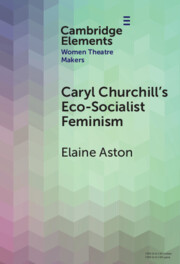Refine search
Actions for selected content:
229 results
Chapter 6 - Staging Utopian Subjects
- from Part II - Building New Communities
-
-
- Book:
- The Cambridge Companion to British Utopian Literature and Culture since 1945
- Published online:
- 18 December 2025
- Print publication:
- 31 January 2026, pp 119-137
-
- Chapter
- Export citation
Curated Conversation 2: Decolonising the Arts in Latin America
- from Part I - Art and Anti-Racism in the Nation
-
-
- Book:
- Art and Anti-Racism in Latin America
- Published online:
- 19 December 2025
- Print publication:
- 29 January 2026, pp 127-134
-
- Chapter
-
- You have access
- Open access
- HTML
- Export citation
6 - Poetics and Theatre Research in the Reconstruction of Afro-Latin American and Mapuche Lives in Argentina
- from Part II - Artistic Practices, Racism and Anti-Racism
-
-
- Book:
- Art and Anti-Racism in Latin America
- Published online:
- 19 December 2025
- Print publication:
- 29 January 2026, pp 205-233
-
- Chapter
-
- You have access
- Open access
- HTML
- Export citation
Introduction
-
- Book:
- Theatre and Censorship in France from Revolution to Restoration
- Published online:
- 30 November 2025
- Print publication:
- 18 December 2025, pp 1-24
-
- Chapter
-
- You have access
- HTML
- Export citation
Chapter 11 - ‘Art Thou Base, Common and Popular?’
- from Part III - ‘One of Us’
-
-
- Book:
- 'The People' and British Literature
- Published online:
- 11 December 2025
- Print publication:
- 11 December 2025, pp 175-188
-
- Chapter
- Export citation
Chapter 1 - Theatre as Technology
-
- Book:
- Theatre as Technology
- Published online:
- 27 November 2025
- Print publication:
- 11 December 2025, pp 1-35
-
- Chapter
-
- You have access
- HTML
- Export citation

Theatre and Censorship in France from Revolution to Restoration
-
- Published online:
- 30 November 2025
- Print publication:
- 18 December 2025

Theatre as Technology
- Apparatus, Nostalgia, Obsolescence
-
- Published online:
- 27 November 2025
- Print publication:
- 11 December 2025
Chapter 3 - Mr Wise and Mr Foolish Go to Town
-
- Book:
- Selling Healing
- Published online:
- 07 November 2025
- Print publication:
- 20 November 2025, pp 47-57
-
- Chapter
- Export citation
3 - Sundaris and Jans in the Age of Mechanical Reprodarshan
-
- Book:
- The Archives and Afterlives of Nautch Dancers in India
- Published online:
- 24 October 2025
- Print publication:
- 13 November 2025, pp 88-133
-
- Chapter
- Export citation

The Archives and Afterlives of Nautch Dancers in India
-
- Published online:
- 24 October 2025
- Print publication:
- 13 November 2025

Caryl Churchill's Eco-Socialist Feminism
-
- Published online:
- 07 October 2025
- Print publication:
- 06 November 2025
-
- Element
- Export citation

English Madrigals on the Jesuit Stage
- Musical Theatre of Martyrdom at the Venerable English College, Rome
-
- Published online:
- 30 September 2025
- Print publication:
- 30 October 2025
-
- Element
- Export citation
Chapter 8 - Michael Field and Verse Drama
- from Part II - Forms and Genres
-
-
- Book:
- Michael Field in Context
- Published online:
- 03 October 2025
- Print publication:
- 25 September 2025, pp 68-76
-
- Chapter
- Export citation
Chapter 25 - Late-Victorian Theatre and the New Drama
- from Part IV - ‘Be contemporaneous’
-
-
- Book:
- Michael Field in Context
- Published online:
- 03 October 2025
- Print publication:
- 25 September 2025, pp 230-238
-
- Chapter
- Export citation
Chapter 35 - Performing Michael Field
- from Part V - Afterlives and Future Fields
-
-
- Book:
- Michael Field in Context
- Published online:
- 03 October 2025
- Print publication:
- 25 September 2025, pp 333-339
-
- Chapter
- Export citation
Chapter 8 - The Healer and the Witch
- from Part II - The Politics of the Irish Revival
-
-
- Book:
- The Revival in Irish Literature and Culture
- Published online:
- 04 September 2025
- Print publication:
- 18 September 2025, pp 164-181
-
- Chapter
- Export citation
Chapter 14 - Intermediality
- from Part II - Themes and Issues
-
-
- Book:
- The Cambridge Companion to Modernist Theatre
- Published online:
- 28 August 2025
- Print publication:
- 11 September 2025, pp 250-266
-
- Chapter
- Export citation
Chapter 9 - Philosophy and Theory
- from Part II - Themes and Issues
-
-
- Book:
- The Cambridge Companion to Modernist Theatre
- Published online:
- 28 August 2025
- Print publication:
- 11 September 2025, pp 163-179
-
- Chapter
- Export citation

The Will in English Renaissance Drama
-
- Published online:
- 04 September 2025
- Print publication:
- 18 September 2025
